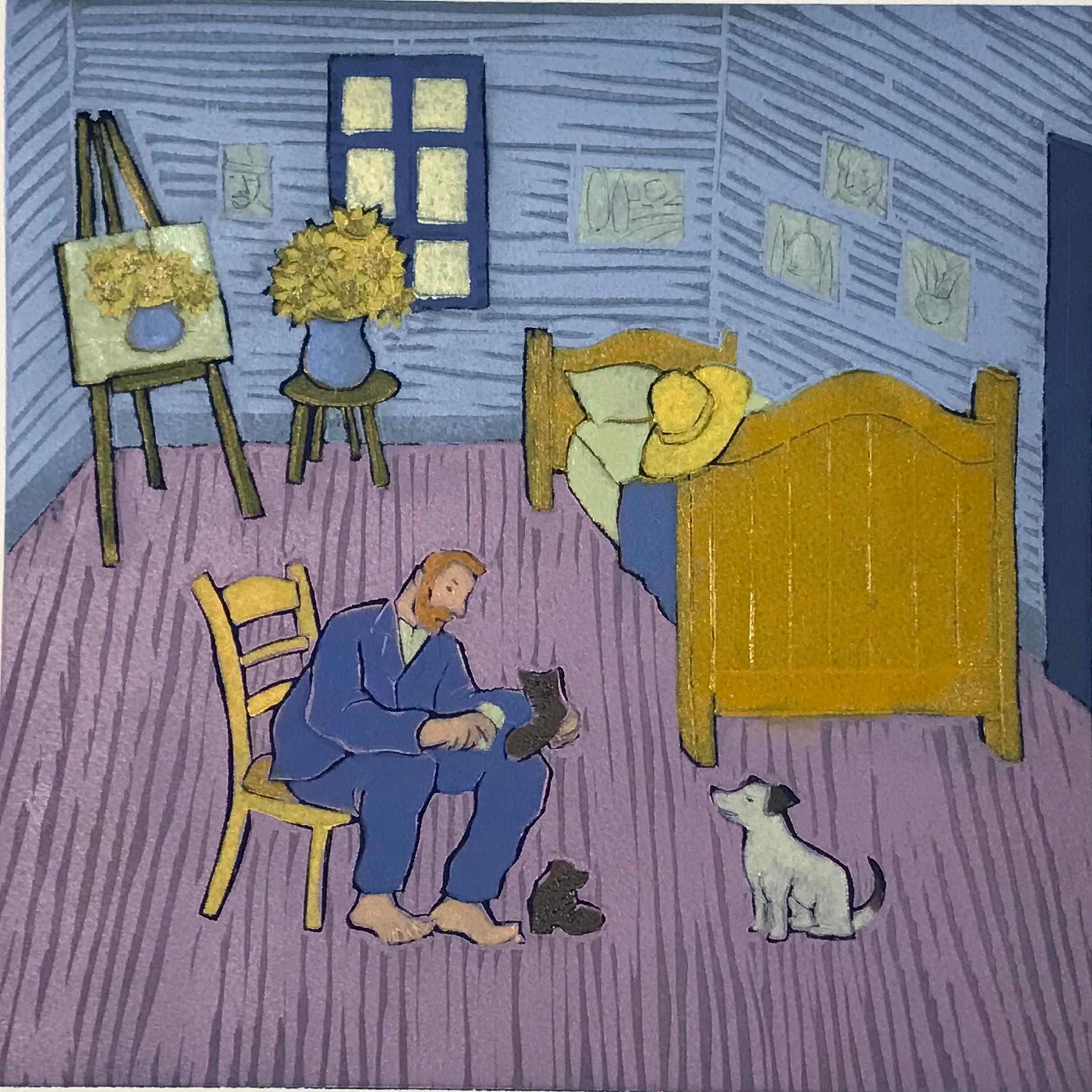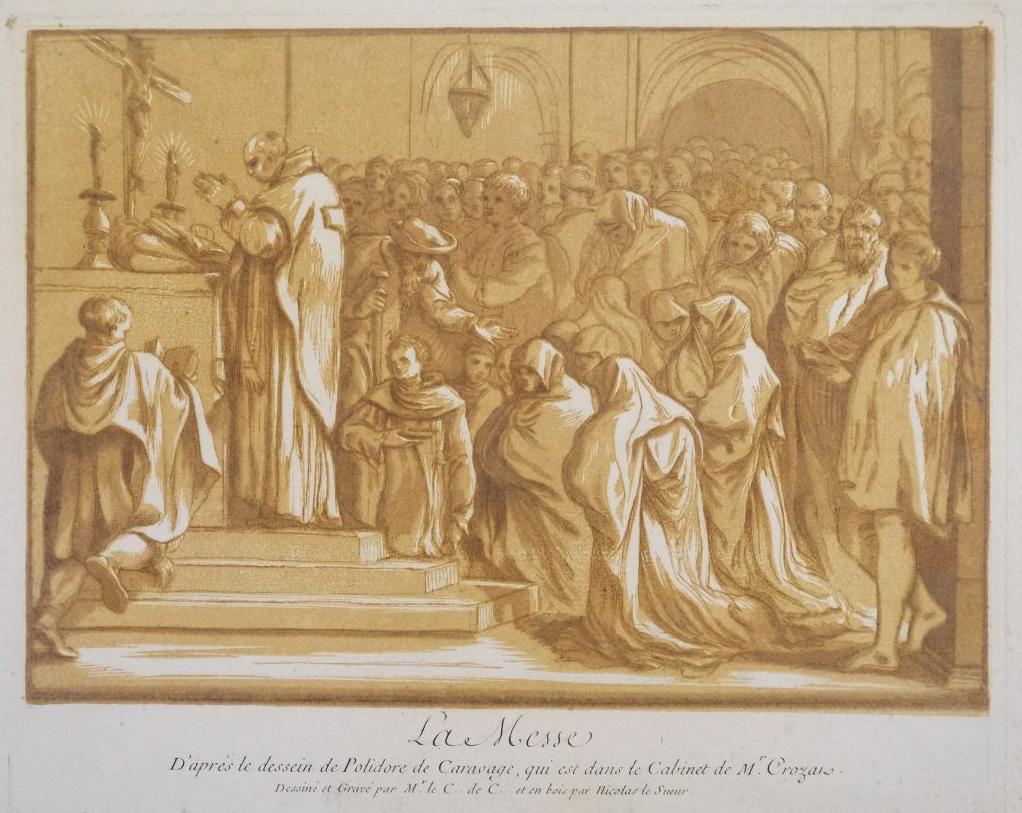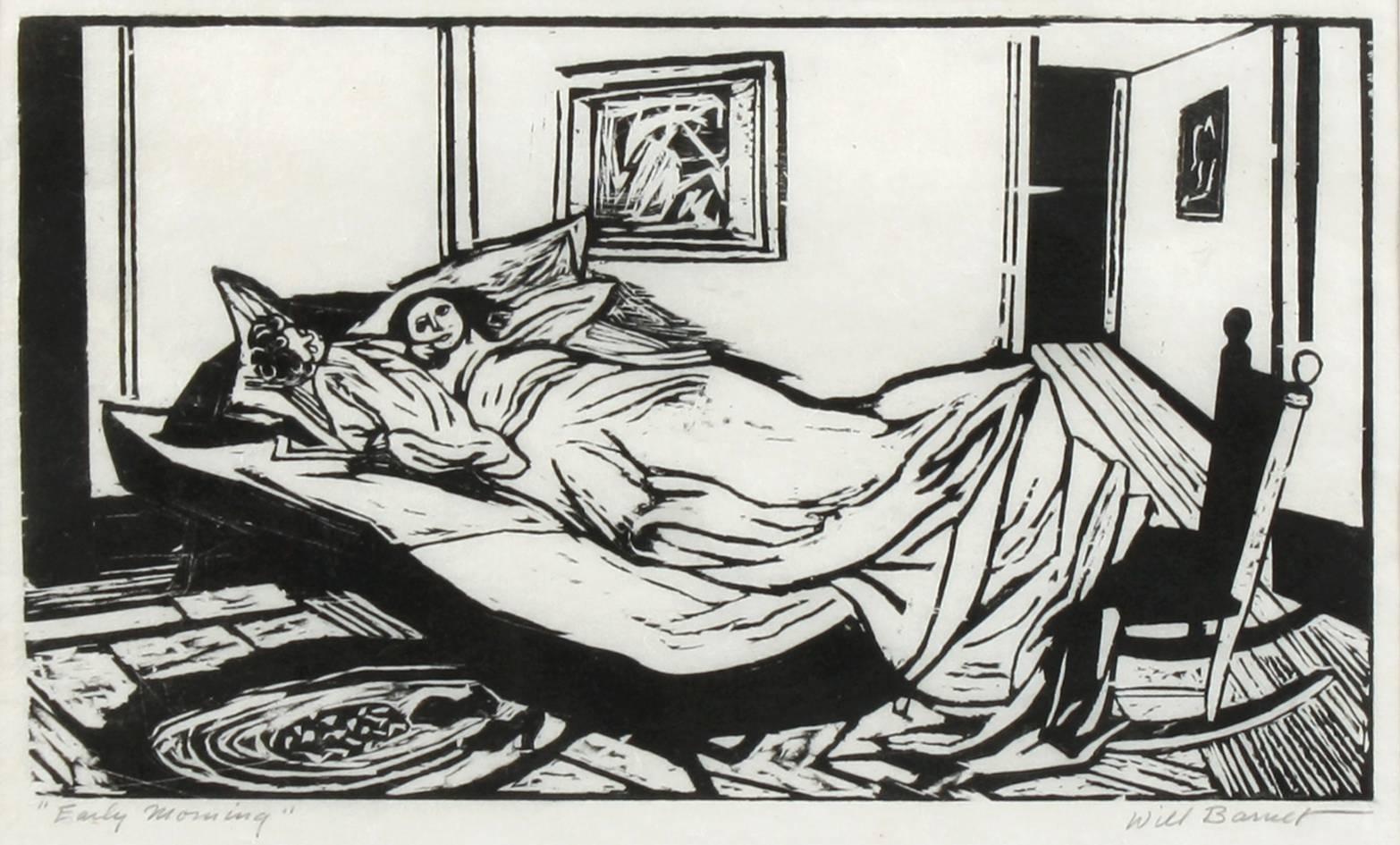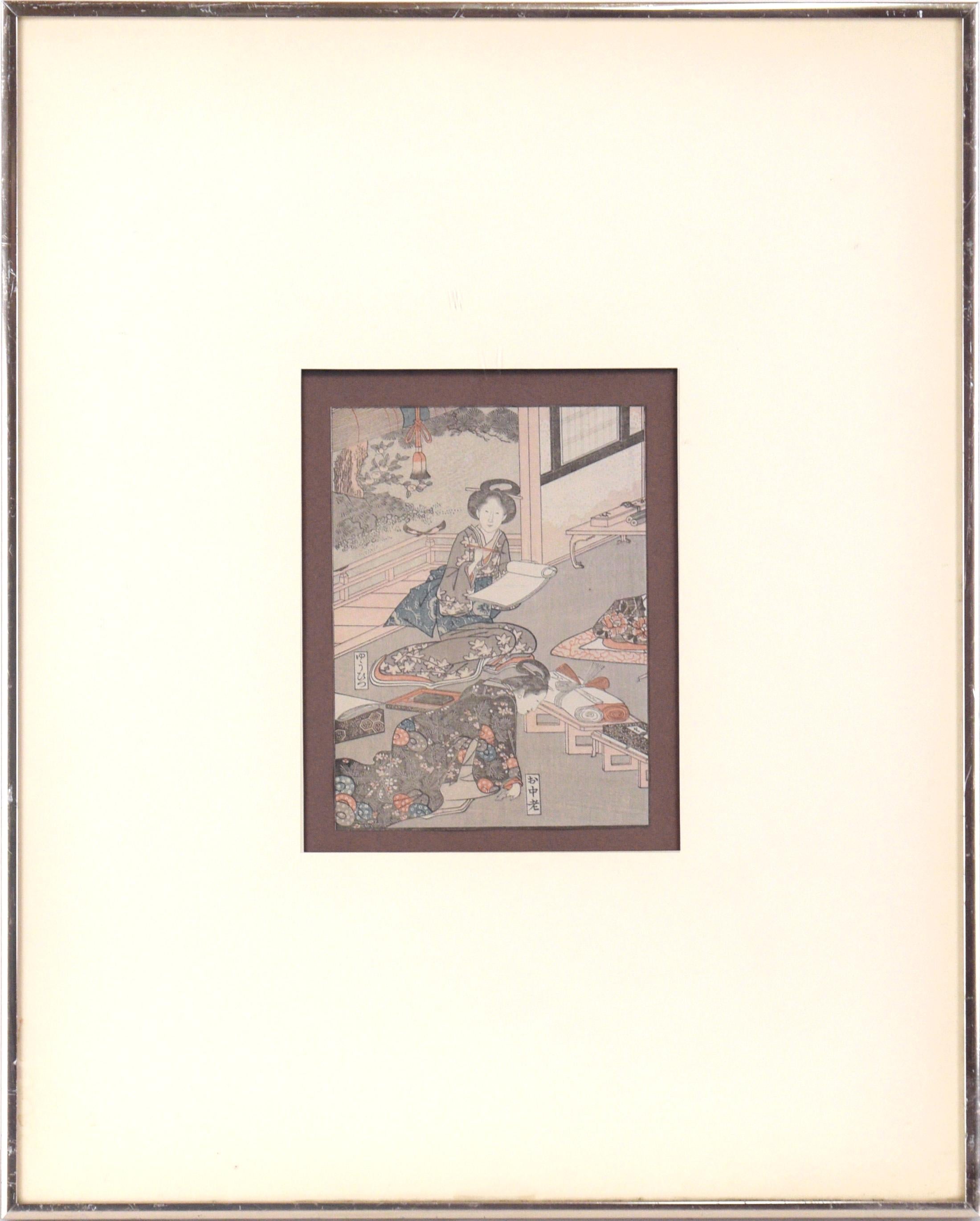Items Similar to Woodcut Print Mimi Grooms Signed Small Edition Happy Birthday Woodblock Print
Want more images or videos?
Request additional images or videos from the seller
1 of 12
Mimi GrossWoodcut Print Mimi Grooms Signed Small Edition Happy Birthday Woodblock Print1957
1957
About the Item
Mimi Gross Grooms (American, born 1940) first print, black and white woodcut or woodblock print on paper
"to... Happy Happy Birthday Lots of love and kisses" 1957.
This possibly an interracial family as one of the kids looks black and one looks white.
Hand signed, signed in monogram, and dated lower right. Titled lower left and to the center. Auction paper labels are attached upper right and lower to the center. Mimi Grooms is known for Painting, book design, mail art, costume and set design, installations. graphic art prints and collectibles.
Dimensions: Matted 20" x 16" in Plate 13 3/8" x 10 3/8" in
Mimi Gross (born 1940) is a New York City born American woman artist.
Mimi Gross's work spans from painting and drawing, films, mail art, book design, costume and set design, indoor and out of doors installations, diorama and sculpture. She is the daughter of the sculptor Chaim Gross. She grew up on the Upper West Side of Manhattan among the artist community of her parents, which included Raphael Soyer, Moses Soyer, Arnold Newman, Max Weber and David Burliuk. From 1963-1976 she was married and collaborated artistically with the artist Red Grooms. As a young artist in the 1960s, Cruz was connected with other artists who were applying abstract expressionism concepts to figurative art such as Lester Johnson, Red Grooms, Cuban artist Emilio Cruz, Bob Thompson and Jan Muller.
She began exhibiting in Provincetown, MA, an artist colony where she spent her summers with her family, in 1957, including a three-woman show at the Sun Gallery in 1958. She had a solo show at the Provincetown Art Association in 1997, as well as several solo shows in various galleries there.
She became well known for large 3-D constructions she made with her husband,including City of Chicago (1967–68), Discount Store (1970–71), Astronauts on the Moon (1972) and Ruckus Manhattan (1975–76).
She has collaborated with the dancer Douglas Dunn on more than 25 dances, designing sets and costumes, beginning with Foot Rules in 1978 and most recently tanks under trees (2008) with text by Anne Waldman and Cassations (2012).
References
Canaday, John (31 May 1969). "Art: Young Unknowns at Guggenheim". New York Times.
Tully, Judd (1977). Red Grooms and Ruckus Manhattan. Scranton, PA: George Braziller.
La Rocco, Claudia (October 9, 2012). "Stream of Fancy, Evading Time". New York Times.
Kokoli, Alexandra M. ed., Feminism Reframed, Swartz, Anne, “The Feminist Art Project,” Newcastle, UK, Cambridge Scholars Publishing, 2008, 293-4.
Kirwin, Liza, More Than Words: Illustrated Letters from the Smithsonian’s Archives of American Art, Princeton, NJ, Princeton Architectural Press, 2005, x, 44-46, 188.
"Mimi Gross," The New Yorker, Apr 17, 2000, 20.
Francine A. Koslow, "Mimi Gross at David Brown Gallery," Artforum, November 1988, 149.
Jeffrey Deitch, "Report from Times Square," Art in America, September 1980, 62.
She has had several international exhibitions, including work at the Salander O’ Reilly Galleries, and the Ruth Siegel Gallery, New York City, the Inax Gallery, in Ginza, Tokyo, and Galerie Lara Vincey, in Paris. She has also shown work at the Municipal Art Society and at the Port Authority Bus Terminal in New York. Her anatomically-themed art-work is on permanent display, courtesy the New York City Parks Department, at the Robert Venable Park in East New York.
Her work is included in numerous public collections, including those of the Metropolitan Museum of Art, the Art Institute of Chicago, the Hirschhorn Museum and Sculpture Garden, the Museum of Contemporary Art in Los Angeles, The Brooklyn Museum, the Jewish Museum, le Musee des Art Decoratifs in Paris, the Nagoya Museum of Art, the Onasch Collection in Berlin and the Lannon Foundation, as well as the Fukuoko Bank in Japan and New York’s Bellevue Hospital.
Gross has been the recipient of countless awards and grants including from the New York State Council on the Arts, twice from the National Endowment for Visual Arts, the American Academy & Institute of Arts and Letters, and a “Bessie” for sets and costumes.
She held the McMillan/Stewart Endowed Chair in Painting at the Maryland College of Art in 2010-2011, and has taught at the Art Institute of Chicago, the Rhode Island School of Design, the Penland School of Crafts, Syracuse University, SUNY Purchase, as well as other universities and educational institutions, giving workshops and advising students, as a visiting artist.
Selected Public Collections:
Art Institute of Chicago,
Brooklyn Museum, NYC,NY
Fukuoku Bank, Fukuoku, Japan
Houston Museum of Art, Houston, Texas
Hirshhorn Museum of Painting and Sculpture, Washington, D.C.
Jewish Museum, NYC,NY
Metropolitan Museum of Art, NYC,NY
Musee des Artes Decoratifs, Costume and Fashion Collection, Paris France
Museum of Contemporary Art, Los Angeles, CA
Nagoya Museum of Art, Nagoya, Japan
Onasch Collection, Pottsdam, Berlin
Selected Group Exhibitions:
To be a Lady, 1285 Ave of the Americas, NYC, N
Putting It Together, David Findley Jr. Gallery, NYC
Loft in the Red Zone, Historic House of JP Morgan, Wall St., NYC, NY
50 Years of Art, Architecture, Photography, Film Video Grimaldi Forum, Espace Ravel, Monaco
The Downtown Show: The New York Art Scene, 1974-84,
Grey Art Gallery,NYC, NY; The Andy Warhol Museum, Pittsburgh, PA.;
New Etchings and Monoprints, VanDeb Editions, NY
Generations, A.I.R. Gallery, Brooklyn, NYC,NY
Displacement: Art + Suitcase, Will Travel, Gertrude Stein Gallery, NYC, NY
Remembering Rudy, Tibor de Nagy Gallery, NYC
Raising Miriam’s Cup, Jewish Community Center, Baltimore, MD
List Graphic Publications, The Jewish Museum, NYC, NY
Voices of Conscience: Then and Now, ACA Galleries, NYC,NY
Painting in Poetry, Poetry in Painting: Wallace Stevens & Modern Art,
- Creator:
- Creation Year:1957
- Dimensions:Height: 20 in (50.8 cm)Width: 16 in (40.64 cm)
- Medium:
- Movement & Style:
- Period:
- Condition:
- Gallery Location:Surfside, FL
- Reference Number:1stDibs: LU38211934152
About the Seller
4.9
Platinum Seller
These expertly vetted sellers are 1stDibs' most experienced sellers and are rated highest by our customers.
Established in 1995
1stDibs seller since 2014
1,556 sales on 1stDibs
Typical response time: 1 hour
- ShippingRetrieving quote...Ships From: Surfside, FL
- Return PolicyA return for this item may be initiated within 3 days of delivery.
More From This SellerView All
- Judaica Jewish Shtetl Etching Hasidic Rabbi at Study Vintage Chassidic PrintBy Paul JeffayLocated in Surfside, FLOlder Chassidic rabbi learning with open book, Judaica, Jewish scenes from a ghetto. Saul Yaffie, a.k.a. Paul Jeffay, (1898–1957) was a Scottish Jewish artist. Known for his charming French street scenes as well as his judaica work. This is signed in the plate and dated 1931 in the print. This is done in a style similar to the works of the early Bezalel School artists Hermann Struck and Jakob Steinhardt. This lithograph, by artist Paul Jeffay depicts a Judaic Shtetl interior scene with great charm and sensitivity. Saul Yaffie was born in Blythswood, Glasgow on 29 April 1898. His mother was Kate Yaffie (née Karkonoski), and his father, Bernard Yaffie, was a master tailor. Like many Russian Jews, Kate and Bernard Yaffie fled persecution in Russia during a wave of anti-Jewish pogroms triggered by the assassination of Tsar Alexander II in 1881. Saul's father was naturalised as a British citizen by the time that Saul himself was three; a Bernard Yaffie is recorded as living at Abbotsford Place in the old Gorbals, where the young Saul spent the early years of his childhood. The Yaffies were not unique in their situation: the Gorbals was the centre of Scotland's Jewish community and home to a large proportion of Glasgow's immigrants throughout the early 20th century. Over time, there was a movement to some of the more affluent communities in Glasgow, such as Pollokshields and Garnethill, as many Jewish families gradually improved their social and economic situation. Like these, the Yaffies also experienced a time of good fortune, moving to a more agreeable address on Sinclair Drive, Cathcart as Bernard's tailoring business prospered. Saul attended day classes in drawing and painting, modelling, and life drawing at The Glasgow School of Art from 1912 to 1919. During the First World War, he was required to interrupt his studies to serve in the King's Own Scottish Borderers in 1916/17. Although subject to military conscription, Yaffie reached the rank of corporal during his service. Prior to his conscription Yaffie engaged in munitions work, something that was recorded in the GSA's student registers. The post-war economic depression that affected the country during the 1920s, also affected the Yaffie family directly: Bernard Yaffie's business suffered greatly, and the family eventually emigrated to Canada. Saul did not emigrate with his family, choosing instead to stay in Europe, and relocate to jazz age Paris where he continued his artistic practice. Now married, Saul sought to escape persecution in Europe by returning to the UK before the Second World War with his wife, Estusia. The two settled in Manchester, but returned to France after the war. In his memoires ‘Bronze in My Blood’, German-born sculptor Benno Schotz describes a Saul ‘Yaffe’, one of only three other Jewish students who attended The Glasgow School of Art at the time. (Schotz himself was exempt from joining the forces because he was ‘not yet a British subject’, and was engaged in war work in the drawing office of John Brown’s shipyards). On the outbreak of the war, Schotz writes, Yaffie won a poster competition to be displayed in Glasgow tramcars at the beginning of the 1914-18 war – his winning design depicted a woman with a child in her arms, fleeing from a fire behind her. While on leave from service, the young Saul told Schotz he had briefly been stationed in the same unit as Jewish American sculptor Jacob Epstein. This was most likely the 38th Battalion of the Royal Fusiliers, also known as ‘the Jewish Legion’, one of five Jewish battalions raised during WW1. ‘He told me how incongruous it was’, remembers Schotz, ‘to See Epstein scrubbing the floor of their hut, with a large diamond ring on his finger’. His work is included in the collection of the Ben Uri Museum in London along with Lucian Freud, David Bomberg, Mark Gertler, Josef Herman, Jankel Adler, Feliks Topolski...Category
20th Century Expressionist Figurative Prints
MaterialsPaper, Etching
- Vintage Russian Ukrainian Shtetl Scene Judaica Lithograph Jewish PortraitBy Anatoli Lvovich KaplanLocated in Surfside, FLPencil signed and dated, Judaica Lithograph. Anatoli Lwowitch Kaplan was a Russian painter, sculptor and printmaker, whose works often reflect his Jewish origins. His father was a b...Category
Mid-20th Century Modern Figurative Prints
MaterialsLithograph
- Vintage Russian Ukrainian Shtetl Scene Judaica Lithograph Jewish PortraitBy Anatoli Lvovich KaplanLocated in Surfside, FLPencil signed and dated, Judaica Lithograph. Anatoli Lwowitch Kaplan was a Russian painter, sculptor and printmaker, whose works often reflect his Jewish origins. His father was a b...Category
Mid-20th Century Modern Figurative Prints
MaterialsLithograph
- Vintage Russian Ukrainian Shtetl Scene Judaica Lithograph Jewish PortraitBy Anatoli Lvovich KaplanLocated in Surfside, FLPencil signed and dated, Judaica Lithograph. Anatoli Lwowitch Kaplan was a Russian painter, sculptor and printmaker, whose works often reflect his Jewish origins. His father was a b...Category
Mid-20th Century Modern Figurative Prints
MaterialsLithograph
- Judaica Jewish Shtetl Etching Yeshiva Talmudic Study Vintage Chassidic Art PrintBy Paul JeffayLocated in Surfside, FL"Qui a raison?" Chassidic boy, Yeshiva student with open book. Judaica, Jewish scenes from a ghetto. Saul Yaffie, a.k.a. Paul Jeffay, (1898–1957) was a Scottish Jewish artist. Known for his charming French street scenes as well as his judaica work. This is signed in the plate and dated 1931 in the print. This is done in a style similar to the works of the early Bezalel School artists Hermann Struck and Jakob Steinhardt. This lithograph, by artist Paul Jeffay depicts a Judaic Shtetl interior scene with great charm and sensitivity. Saul Yaffie was born in Blythswood, Glasgow on 29 April 1898. His mother was Kate Yaffie (née Karkonoski), and his father, Bernard Yaffie, was a master tailor. Like many Russian Jews, Kate and Bernard Yaffie fled persecution in Russia during a wave of anti-Jewish pogroms triggered by the assassination of Tsar Alexander II in 1881. Saul's father was naturalised as a British citizen by the time that Saul himself was three; a Bernard Yaffie is recorded as living at Abbotsford Place in the old Gorbals, where the young Saul spent the early years of his childhood. The Yaffies were not unique in their situation: the Gorbals was the centre of Scotland's Jewish community and home to a large proportion of Glasgow's immigrants throughout the early 20th century. Over time, there was a movement to some of the more affluent communities in Glasgow, such as Pollokshields and Garnethill, as many Jewish families gradually improved their social and economic situation. Like these, the Yaffies also experienced a time of good fortune, moving to a more agreeable address on Sinclair Drive, Cathcart as Bernard's tailoring business prospered. Saul attended day classes in drawing and painting, modelling, and life drawing at The Glasgow School of Art from 1912 to 1919. During the First World War, he was required to interrupt his studies to serve in the King's Own Scottish Borderers in 1916/17. Although subject to military conscription, Yaffie reached the rank of corporal during his service. Prior to his conscription Yaffie engaged in munitions work, something that was recorded in the GSA's student registers. The post-war economic depression that affected the country during the 1920s, also affected the Yaffie family directly: Bernard Yaffie's business suffered greatly, and the family eventually emigrated to Canada. Saul did not emigrate with his family, choosing instead to stay in Europe, and relocate to jazz age Paris where he continued his artistic practice. Now married, Saul sought to escape persecution in Europe by returning to the UK before the Second World War with his wife, Estusia. The two settled in Manchester, but returned to France after the war. In his memoires ‘Bronze in My Blood’, German-born sculptor Benno Schotz describes a Saul ‘Yaffe’, one of only three other Jewish students who attended The Glasgow School of Art at the time. (Schotz himself was exempt from joining the forces because he was ‘not yet a British subject’, and was engaged in war work in the drawing office of John Brown’s shipyards). On the outbreak of the war, Schotz writes, Yaffie won a poster competition to be displayed in Glasgow tramcars at the beginning of the 1914-18 war – his winning design depicted a woman with a child in her arms, fleeing from a fire behind her. While on leave from service, the young Saul told Schotz he had briefly been stationed in the same unit as Jewish American sculptor Jacob Epstein. This was most likely the 38th Battalion of the Royal Fusiliers, also known as ‘the Jewish Legion’, one of five Jewish battalions raised during WW1. ‘He told me how incongruous it was’, remembers Schotz, ‘to See Epstein scrubbing the floor of their hut, with a large diamond ring on his finger’. His work is included in the collection of the Ben Uri Museum in London along with Lucian Freud, David Bomberg, Mark Gertler, Josef Herman, Jankel Adler, Feliks Topolski...Category
20th Century Expressionist Interior Prints
MaterialsEtching
- Still Life with Hans Maler Pop Art Serigraph Hand SignedBy Josef LeviLocated in Surfside, FLOn deckle edged watermarked Arches French paper. hand signed in pencil, dated and numbered. the edition size is 175. there are three states of the same image image each with increasing detail and color. This is just for the one in the photo. Josef Alan Levi (1938) is an American artist whose works range over a number of different styles, but which are unified by certain themes consistently present among them. Josef Levi began his artistic career in the 1960s and early '70s, producing highly abstract and very modernist pieces: these employing exotic materials such as light fixtures and metallic parts. By 1975, Levy had transitioned to painting and drawing still lifes. At first these were, traditionally, of mundane subjects. Later, he would depict images from art history, including figures originally created by the Old Masters. Around 1980, he made another important shift, this time toward creating highly precise, though subtly altered reproductions of pairs of female faces which were originally produced by other artists. It is perhaps this work for which he is most well known. Since around 2000, Josef Levi has changed the style of his work yet again: now he works entirely with computers, using digital techniques to abstract greatly from art history, and also from other sources. Levi's works of art in the collections of the Museum of Modern Art, NYC, the National Gallery of Art, and the Albright-Knox Museum, among many others. Levi's art has been featured on the cover of Harper's Magazine twice, once in June 1987, and once in May 1997. Josef Levi received a Bachelor of Arts degree in 1959 from the University of Connecticut, where he majored in fine arts and minored in literature. From 1959 to 1960, he served to a first lieutenant in the U.S. Army, and from 1960 through 1967 he was in the U.S. Army Reserves. In 1966, he received the Purchase Award from the University of Illinois in 1966, and he was featured in New Talent U.S.A. by Art in America. He was an artist in residence at Appalachian State University in 1969, taught at Farleigh Dickenson University in 1971 and was a visiting professor of art at Pennsylvania State University in 1977. From 1975 to 2007, Levi resided in New York City. He now lives in an apartment in Rome, where he is able to paint with natural light as he was unable in New York. From 1959 to 1960, Josef took some courses of Howard McParlin Davis and Meyer Schapiro at Columbia University which initiated him into the techniques of reproducing the works of the Old Masters. His first works, created in the 1960s, were wood and stone sculptures of women. His first mature works were abstract pieces, constructed of electric lights and steel. In 1970, Levi's materials included fluorescent light bulbs, Rust-Oleum and perforated metal in addition to paint and canvas. By 1980, Josef Levi's art had transformed into a very specific form: a combination of reproductions of female faces which were originally depicted by other artists. The faces which he reproduces may be derived from either portraits or from small portions of much larger works; they are taken from paintings of the Old Masters, Japanese ukiyo-e, and 20th-century art. Artists from whom he has borrowed include: Vermeer, Rembrandt, Piero della Francesca, Botero, Matisse, Utamaro, Correggio, Da Vinci, Picasso, Chuck Close, Max Beckmann, Pisanello, Lichtenstein. The creation of these works is informed by Levi's knowledge and study of art history. Josef Levi's paintings from this period are drawn, then painted on fine linen canvas on wooden stretchers. The canvas is coated with twenty-five layers of gesso in order to produce a smooth surface on which to work. The drawing phase takes at least one month. Levi seals the drawing with acrylic varnish, and then he may apply layers of transparent acrylic in order to approximate the look of old paintings. After the last paint is applied, another layer of acrylic varnish is sprayed on to protect the work. Most of the figures in his contemporary pieces are not paired with any others. SELECTED COLLECTIONS MUSEUM OF MODERN ART, NEW YORK, NY ALBRIGHT- KNOX GALLERY, BUFFALO, NY ALDRICH MUSEUM OF CONTEMPORARY ART, RIDGEFIELD, CT NATIONAL GALLERY OF ART, WASHINGTON, DC BROOKLYN MUSEUM OF ART, BROOKLYN, NY SMITHSONIAN NATIONAL MUSEUM OF AMERICAN HISTORY, WASHINGTON, DC CORCORAN GALLERY, WASHINGTON, DC UNIVERSITY OF NOTRE DAME ART...Category
1970s Pop Art Figurative Prints
MaterialsLithograph, Screen
You May Also Like
- Once upon a time in London, Morning, Woodcut print, Vincent Van Gogh, SunflowersBy Mychael BarrattLocated in Deddington, GBA limited edition woodcut on paper print by Mychael Barratt of Vincent Van Gogh in his bedroom with his dog. Sunflowers appear in the background, brightening up a blue and purple room. Additional information: Mychael Barratt Once upon a time in London, Morning Woodcut on paper Signed and titled in pencil Numbered from the edition of 100 Image size Height: 27.5 cm Width: 27 cm Complete size of sheet Height: 39.6 cm Width: 37.5 cm Depth: 0.2 cm ARTIST PROFILE: Mychael Barratt was born in Toronto, Canada, however, considers himself to be a Londoner since arriving for what was supposed to be a two-week stay thirty years ago. He is a narrative artist whose work is steeped in imagery relating to art history, literature, theatre and everything else that overfills his bookshelves. He was an artist in residence for Shakespeare’s Globe Theatre...Category
2010s Contemporary Figurative Prints
MaterialsPaper, Woodcut
- Dickie (Child in High Chair)By Will BarnetLocated in Buffalo, NYAn original woodcut on japan paper created by master American artist Will Barnet in 1942.Category
1940s American Modern Figurative Prints
MaterialsWoodcut, Paper
- La Messe (The Mass), after CaravaggioLocated in Middletown, NYChiaroscuro woodcut with underlying engraving on cream laid paper, printed from two blocks in brown and olive. 10 1/4 x 12 3/4 inches (260 x 321 mm) (plate), full margins with the text printing clearly below in black ink. In very good condition with scattered surface soiling and several minor flecks of light discoloration in the margins, especially in the area of the lower right corner, well outside of image area. Unobtrusive notations in pencil in the margin and on the verso. All condition issues are consistent with age. After a drawing of the same title by Polidoro da Caravaggio...Category
Mid-18th Century Old Masters Figurative Prints
MaterialsEngraving, Laid Paper, Woodcut
- Early MorningBy Will BarnetLocated in Buffalo, NYA nice rare woodcut by the noted American Artist Will Barnet. This woodcut is from 1939 and is titled and pencil signed on the base "Early Morning", Will...Category
1930s American Modern Figurative Prints
MaterialsWoodcut, Paper
- Scribe and Personal Assistant to the Shogun - Japanese Woodblock Print on PaperLocated in Soquel, CAScribe and Personal Assistant to the Shogun - Japanese Woodblock Print on Paper Detailed woodblock print by an unknown artist, In the style of Suzuki Harunobu. There are two women i...Category
19th Century Edo Figurative Prints
MaterialsPaper, Ink, Woodcut
- The Four Seasons: Spring Japanese Woodblock Triptych ink on Paper Tales of GenjiLocated in Soquel, CAThe Four Seasons: Spring - Japanese Woodblock Triptych in Ink on Paper Colorful kabuki scene by Utagawa Kuniteru (Japanese, active 1818-18...Category
Early 19th Century Edo Figurative Prints
MaterialsPaper, Ink, Woodcut
Recently Viewed
View AllMore Ways To Browse
Large Happy
Vintage French Fashion Prints
Vintage Chair Prints
Vintage Birthday
Vintage Birthday Signs
Vintage In N Out Sign
Happy Birthday
Happy Store
Love Small 17
American Woodblock Prints
Store Display Sign
Vintage Tissue
Black And White Woodcuts
Woodcut Print Black And White
Vintage Groom
Vintage Grooming
Vintage Grooms
Large Woodblock





